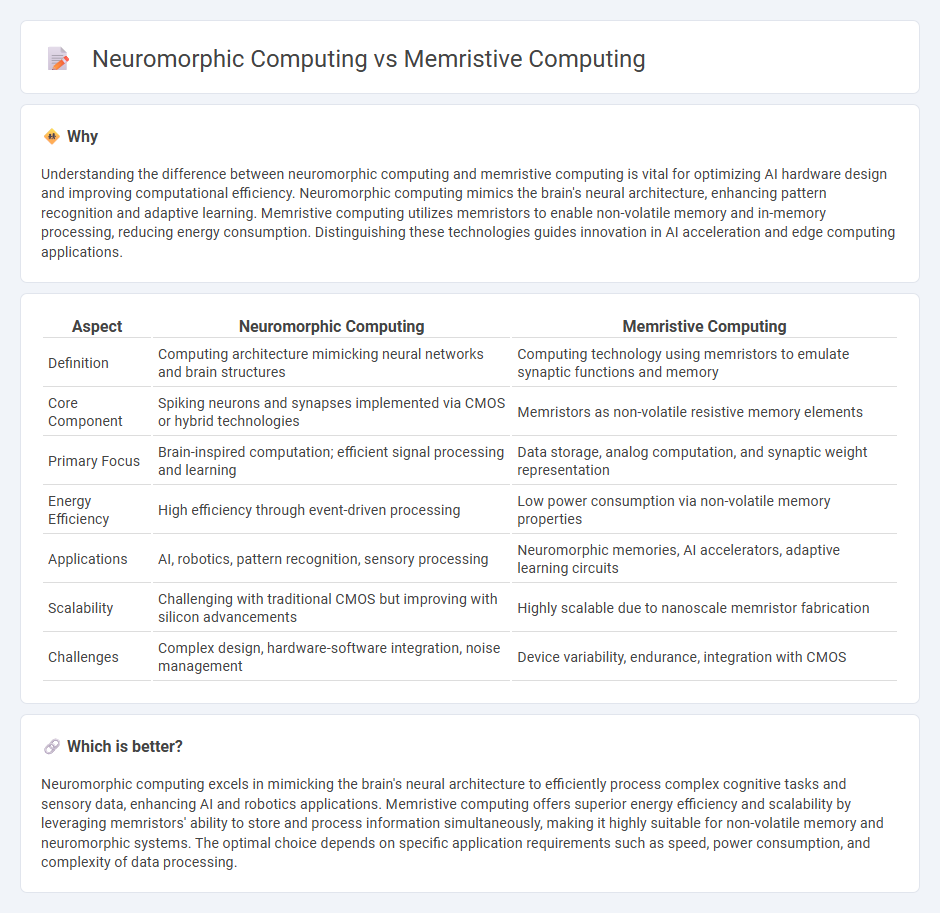
Neuromorphic computing mimics the neural architecture of the human brain to achieve efficient processing and low power consumption, integrating artificial neurons and synapses for enhanced AI performance. Memristive computing utilizes memristors--resistive memory devices that retain resistance states--to enable non-volatile memory and mimic synaptic functions in hardware. Explore the nuances of these pioneering technologies to understand their impact on future computing paradigms.
Why it is important
Understanding the difference between neuromorphic computing and memristive computing is vital for optimizing AI hardware design and improving computational efficiency. Neuromorphic computing mimics the brain's neural architecture, enhancing pattern recognition and adaptive learning. Memristive computing utilizes memristors to enable non-volatile memory and in-memory processing, reducing energy consumption. Distinguishing these technologies guides innovation in AI acceleration and edge computing applications.
Comparison Table
| Aspect | Neuromorphic Computing | Memristive Computing |
|---|---|---|
| Definition | Computing architecture mimicking neural networks and brain structures | Computing technology using memristors to emulate synaptic functions and memory |
| Core Component | Spiking neurons and synapses implemented via CMOS or hybrid technologies | Memristors as non-volatile resistive memory elements |
| Primary Focus | Brain-inspired computation; efficient signal processing and learning | Data storage, analog computation, and synaptic weight representation |
| Energy Efficiency | High efficiency through event-driven processing | Low power consumption via non-volatile memory properties |
| Applications | AI, robotics, pattern recognition, sensory processing | Neuromorphic memories, AI accelerators, adaptive learning circuits |
| Scalability | Challenging with traditional CMOS but improving with silicon advancements | Highly scalable due to nanoscale memristor fabrication |
| Challenges | Complex design, hardware-software integration, noise management | Device variability, endurance, integration with CMOS |
Which is better?
Neuromorphic computing excels in mimicking the brain's neural architecture to efficiently process complex cognitive tasks and sensory data, enhancing AI and robotics applications. Memristive computing offers superior energy efficiency and scalability by leveraging memristors' ability to store and process information simultaneously, making it highly suitable for non-volatile memory and neuromorphic systems. The optimal choice depends on specific application requirements such as speed, power consumption, and complexity of data processing.
Connection
Neuromorphic computing and memristive computing are interconnected through their efforts to emulate the human brain's neural architecture using hardware that mimics synaptic functions. Memristors serve as fundamental components in neuromorphic systems by providing adaptive, non-volatile memory essential for synaptic weight storage and dynamic learning processes. This synergy enhances computational efficiency and energy savings in artificial intelligence and cognitive computing applications.
Key Terms
Resistance Switching (Memristors)
Memristive computing leverages resistance switching mechanisms in memristors to store and process information through variable resistance states, enabling high-density, low-power memory and logic operations. Neuromorphic computing mimics neural architectures by integrating memristors as synaptic elements to emulate synaptic plasticity and enhance adaptive learning processes. Explore how resistance switching in memristors advances both computing paradigms for next-generation AI applications.
Spiking Neural Networks
Memristive computing leverages memristors to emulate synaptic weights, enabling energy-efficient, non-volatile hardware ideal for implementing Spiking Neural Networks (SNNs) with high memory density and low power consumption. Neuromorphic computing broadly encompasses hardware architectures inspired by the brain, including SNNs, emphasizing real-time processing and event-driven spikes to mimic neural activity. Explore how these approaches differ in hardware implementation and efficiency for advanced SNN applications.
Synaptic Plasticity
Memristive computing leverages resistive memory elements to mimic synaptic plasticity by dynamically adjusting resistance states, enabling energy-efficient and high-density memory integration for adaptive learning processes. Neuromorphic computing emulates biological neural networks through hardware architectures that replicate synaptic behavior and plasticity mechanisms, facilitating real-time processing and efficient neural signal modulation. Explore how advancements in synaptic plasticity models enhance both memristive and neuromorphic systems to revolutionize artificial intelligence applications.
Source and External Links
Toward memristive in-memory computing: principles and applications - Memristive computing offers an in-memory computing paradigm that integrates memory and processing to overcome data transfer bottlenecks in traditional architectures, with applications spanning neural networks, machine learning, scientific computing, and digital image processing.
Pinaki Mazumder co-authors new book: Memristive Computing - A recently published book explores memristive computing's role in neuromorphic computing, AI, cryptography, and signal processing, highlighting its basis in materials science, device physics, and computer science.
Memristive technologies for data storage, computation, encryption ... - Memristive devices enable nonvolatile memory states used for data storage and low-energy computing, with potential for edge and always-on computing systems despite higher manufacturing costs compared to mainstream memory.
 dowidth.com
dowidth.com